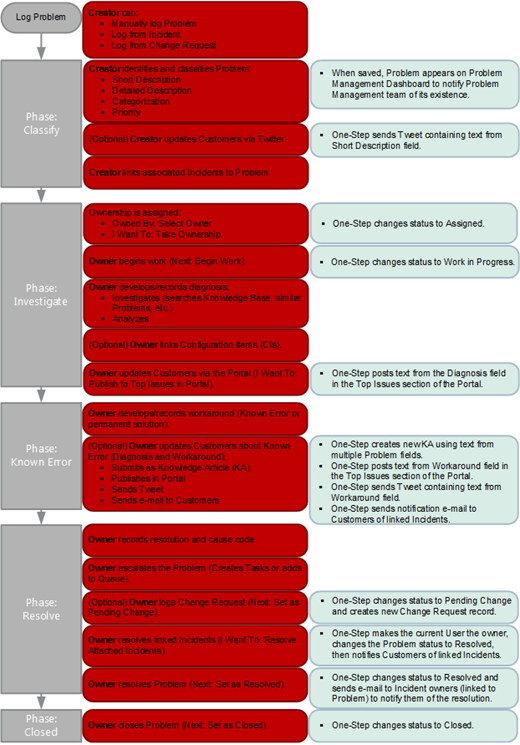Problem Workflow
The following figure shows the high-level Problem process workflow in the OOTB system.

Note: CSM uses several features to manage the Problem workflow (ex: The
Problem Form helps create and manage Problems,
One-Step Actions help move the Problem through its workflow, Automation Processes
notify stakeholders via e-mails, a Problem Dashboard notifies stakeholders and
tracks metrics, etc.).
Contributors
A Problem typically involves the following contributors:
- Creator: User who first logs the Problem. This is typically a member of the Problem Management Team.
- Owner: User who manages the Problem. This is typically an IT manager who is a member of the Problem Management Team.
Phases:
The Problem workflow is divided into the following phases:
- Classify: Creator logs a new Problem. Then, the creator identifies and classifies the Problem (Description, Service, Category, and Priority). The creator updates Customers via Twitter and links related Incidents to the record.
- Investigate: Ownership is assigned. The owner begins work, investigates and analyzes the Problem, and then records a diagnosis. The owner updates Customers by publishing the Problem to the Portal, and then links Configuration Items (CIs).
- Known Error: Owner develops and records the workaround. Then, the owner can update Users (by submitting a Knowledge Article to Knowledge Base) and Customers (by publishing a known error to Customer Portal, post to Twitter, or send e-mail).
- Resolve: Owner records resolution details and cause code. Then, the owner can escalate the Problem and/or log a Change Request required to solve the Problem (if necessary). The owner then resolves attached Incidents before resolving the Problem.
- Closed: Owner closes the Problem.
Statuses
A Problem progressing through the workflow encounters the following statuses:
- New: Problem is being logged, identified, and classified.
- Assigned: Problem has been assigned to an owner.
- Work in Progress: Problem is being diagnosed, investigated, and analyzed.
- Pending Change: Problem process is on hold until a Change Request is implemented.
- Resolved: Problem is resolved.
- Closed:
Problem is closed.
Note: Problem statuses do not align with Problem phases.
